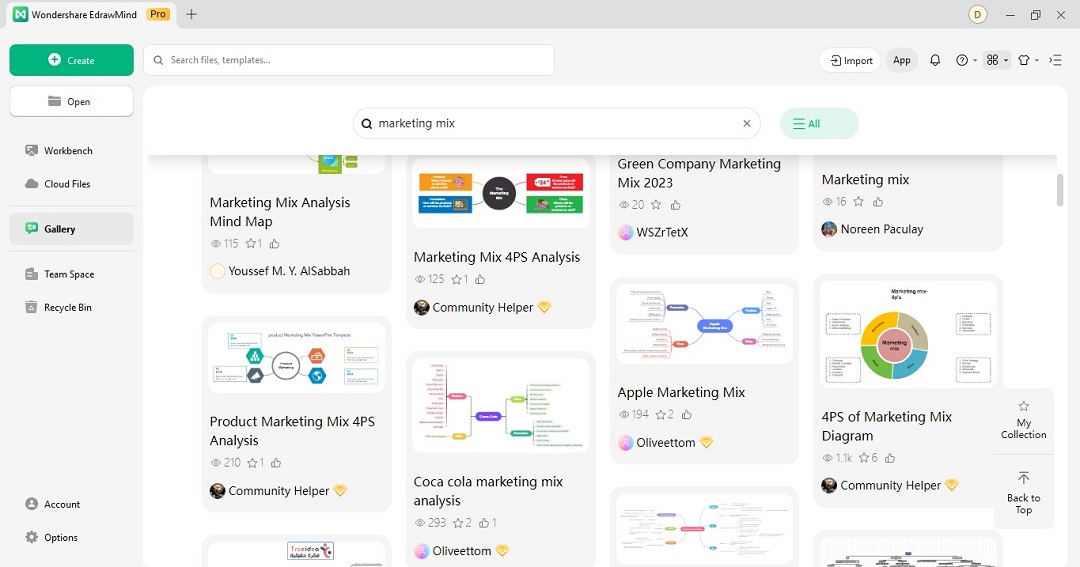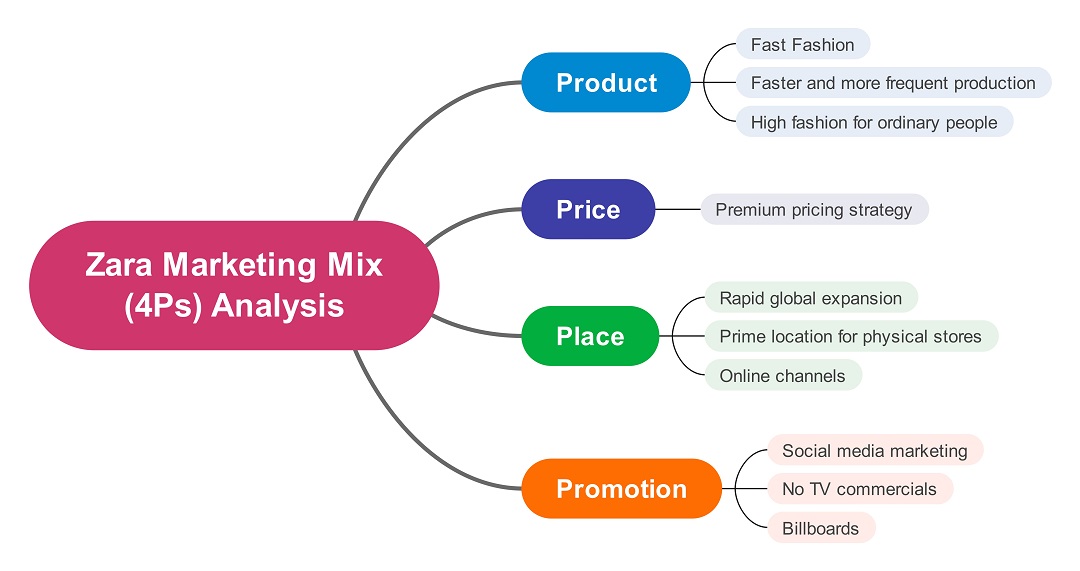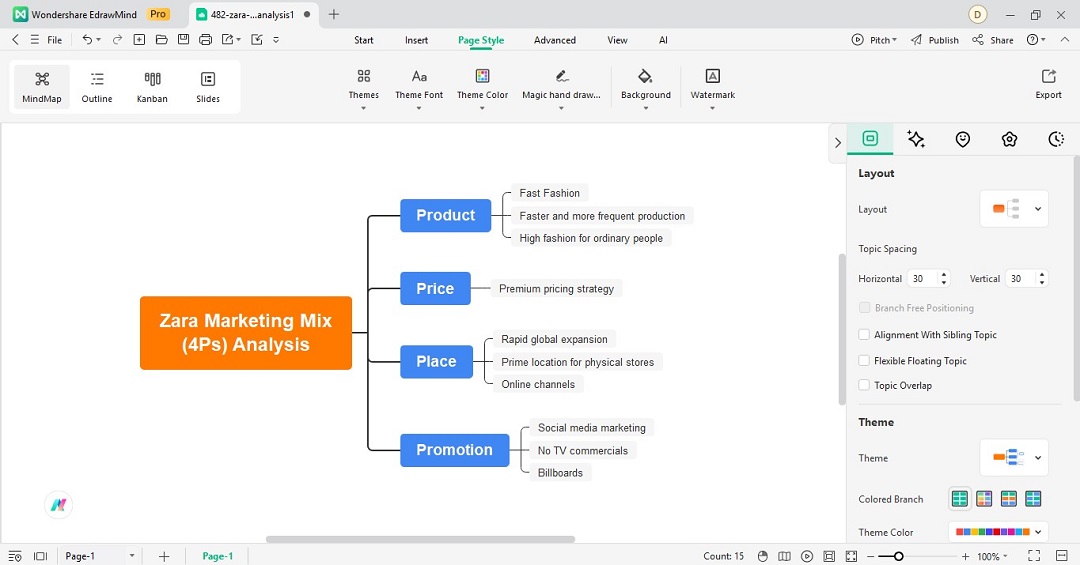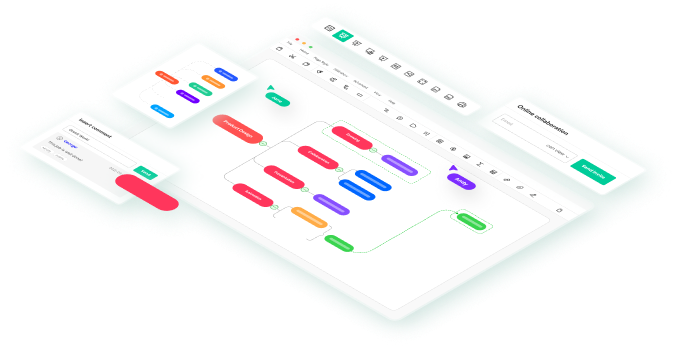Zara doesn’t just follow trends—it dictates them. While competitors scramble to catch up, Zara’s lightning-speed supply chain delivers runway-to-rack styles in 15 days flat. The secret? A marketing mix (4Ps) so sharp, it turns fleeting trends into billion-dollar profits.
In this article
In this deep dive, we’ll unpack:
- Product: How Zara’s “see now, buy now” model makes others look slow
- Price: The psychological tricks behind €49.90 price tags
- Place: Why you’ll always find Zara next to luxury brands
- Promotion: Their “no ads, all hype” playbook
Bonus: Stick around for a free tool to map any brand’s 4Ps like a pro.
Zara’s Product Strategy: Why You Can’t Stop Buying Their Clothes
If you’re like me, you’ve walked into Zara for "just a quick look" and walked out with a bag full of clothes you might wear someday. Blame it on Zara’s brilliant product strategy—it’s designed to make you impulse-shop.
Let’s break down how Zara uses the 4Ps of marketing (Product, Price, Place, Promotion) to dominate fast fashion—and why you’ll never see them drowning in discounts.
1. “Fast Fashion”? Try “Flash Fashion”
Zara doesn’t follow trends—it steals them at lightning speed.
- From runway to store in 2 weeks (others could take 5+ weeks).
- New drops twice a week, so you always feel FOMO.
- “Inspired” by luxury brands (aka that Zara blazer that looks suspiciously like a $3,000 Max Mara).
Hot Take:
“Zara’s designers must have a time-turner. While other brands are still sketching, Zara’s already sold out.”
2. Fake Scarcity = Real Urgency
Zara’s secret weapon? Limited stock.
- No “seasonal collections”—just constant mini-drops (Spring/Summer 2025? More like “Week 25”).
- Collabs that vanish fast (RIP, Havaianas x Zara flip-flops).
- Low restocks—if you hesitate, it’s gone.
Why it works:
“Zara treats clothes like TikTok trends: viral today, forgotten tomorrow. And we keep scrolling… I mean, shopping.”
3. Something for Everyone (But Not Too Much)
Zara’s range is wide but curated—no overwhelming aisles of 50 nearly-identical tees.
- Women’s section: Office-to-brunch outfits (linen sets, slip dresses).
- Men’s section: From “relaxed dad vibes” to “sharp enough for a date.”
- Kids’ line: Tiny trendsetters (even babies get mini trench coats).
Blogger Confession:
“My wife once bought a Zara kids’ sweater. No regrets—it fit perfectly and cost half the price.”
The Bottom Line
Zara’s product strategy is a psychological masterclass:
✅ Speed = Always fresh.
✅ Scarcity = Buy now, think later.
✅ Selection = Just enough to tempt you.
Final Thought: “Zara doesn’t sell clothes—it sells the idea that you’ll be cooler if you buy them. And honestly? It’s working.”

Zara's Pricing & Store Strategy: Why You'll Pay More (And Feel Good About It)
Zara could sell $5 t-shirts like other fast fashion brands, but it doesn’t. Here’s how their pricing psychology and strategic store placement make you happy to spend €29.90 on a blouse you’ll only wear twice.
💰 Zara’s Pricing: The "Affordable Luxury" Illusion
1. The "Not Cheap, Not Crazy" Sweet Spot
- A Zara linen dress costs €49.90—not H&M’s €24.99, but not & Other Stories’ €89 either.
- Why it works: That €50 price tag makes you think "It’s basically designer!" (even though it’s polyester).
2. Discounts? Barely. FOMO? Always.
- Zara’s "Special Prices" section is like a VIP club:
✅ "Up to 40% off!" (but most items are only 15% off)
✅ Limited sizes/colors (so you panic-add to cart)
- Pro tip: Check the app on Thursdays—that’s when markdowns quietly appear.
3. The Magic of €9.90
Odd pricing isn’t just about saving 10 cents:
- €39.90 feels "under €40" (even though it’s basically €40).
- €79.90 sounds like "investment piece" instead of "€80 for a trendy jacket."
Blogger Confession: "I once justified buying Zara’s €129 faux-leather pants because ‘real leather would cost €500!’ …They peeled after three wears."
📍 Zara’s Place Strategy: Stores Designed for Impulse Buys
1. They’re Everywhere (But Feel Exclusive)
- 2,000+ stores in luxury-adjacent locations:
✅Next to Apple Stores (for the aspirational crowd)
✅Down the hall from Louis Vuitton (so you think "I’m being frugal!")
- Fun fact: Zara’s flagship in Madrid has seven floors—it’s basically a fashion theme park.
2. The Store Layout is a Trap
- Ground floor: Trendiest pieces (so you grab something immediately).
- Fitting rooms downstairs (forcing you to walk past more clothes).
- Minimal stock on display (so you worry about missing out).
3. Online = Dangerously Easy
- The app notifies you when “your size is back in stock” (aka "Buy it before someone else does!").
- Free returns (which makes you order three sizes "just to be safe").
Shopping Hack: "Zara’s website shows new arrivals at midnight CEST. Set an alarm if you want the viral item before resellers do."
Why This Works
Zara’s price + place combo creates urgency:
- "This costs just enough to feel special."
- "It’s right here in this fancy mall—I deserve it."
Final Thought: "Zara doesn’t sell clothes—it sells the fantasy that you’re the kind of person who wears something once and moves on. (And we keep buying into it.)"
Image Source: Freepik.com

Zara’s Promotion Strategy: Why They Ignore Sales (And Still Win)
Zara doesn’t blast “50% OFF!” signs or spam your inbox. Instead, their promotion strategy is like a stealthy fashion heist: quiet, calculated, and wildly effective. Here’s how they market without seeming to market at all.
1. The Store is the Ad
Zara’s physical shops are psychological traps disguised as minimalist boutiques:
- Lighting: Bright enough to see seams, dim enough to hide polyester’s cheap sheen.
- Layout: Trendiest pieces at eye level, basics tucked away (so you grab the “cool” item first).
- Bags: That crinkly paper tote is a walking billboard—it screams “I have taste” without a logo in sight.
Blogger Confession: “I once bought a Zara blazer just because the store smelled like cedar and expensive decisions.”
2. Ads? Barely. Aesthetic? Obsessively.
Zara’s rare campaigns are masterclasses in less-is-more:
- Black-and-white photography (e.g., Studio Fall 2024) featuring supermodels mid-stride—no cheesy smiles, just attitude.
- Zero discounts promoted (unlike H&M’s “EXTRA 30% OFF SALE!” chaos).
- Logo hidden or tiny (because you already know it’s Zara).
Why it works:
“Zara treats ads like art gallery openings—exclusive enough to feel special, simple enough to go viral.”
3. Word-of-Mouth is Their Best Salesperson
Zara fuels organic buzz instead of paying for it:
- #ZaraHaul has 3.2B views on TikTok.
- Micro-influencers post Zara dupes (“This dress looks like Jacquemus for 1/10th the price!”).
- No celebrity endorsements—because real people are their best models.
Pro Tip: “Search ‘Zara + [current month]’ on Instagram to find hidden gems before they sell out.”
4. Digital Presence: Cool Girl Energy
Zara dominates every platform—but differently:
- Instagram: Flat-lay outfits with neutral backgrounds (no loud graphics).
- TikTok: Silent catwalk clips (no cringey voiceovers).
- Spotify: Curated playlists (like their 50th-anniversary collab) to soundtrack your “Zara girl” fantasy.
Fun Fact: Their YouTube channel has zero “BUY NOW” links—just cinematic runway films.
Why This Works
Zara’s promotion isn’t about shouting—it’s about subtle seduction:
✅ “You’re not shopping, you’re curating.”
✅ “You discovered this brand yourself (because Zara planted the idea).”
✅ “No pressure to buy… but you’ll regret it if you don’t.”
Final Thought: “Zara doesn’t sell clothes. They sell the identity of someone who ‘just throws things on’ but looks expensive.”
Bonus: Easily Create a Zara Marketing Mix (4Ps) Diagram for Free
You’ve seen how the 4Ps marketing mix of Zara works. From the product down to promotion, everything plays a part in keeping the brand ahead. Now, maybe you're doing a report, working on a class project, or want to visualize the 4Ps for easy understanding. Visualization can help you connect the dots and explain your points better.
Instead of drawing boxes by hand, you can use a free mind mapping tool to save time. Wondershare EdrawMind makes it quick to build a marketing mix (4Ps) for Zara using pre-made templates. It’s simple to use and helps your work stand out, whether you're doing it solo or as a group.
EdrawMind Key Features
Here's what you get when using EdrawMind for making marketing mix diagrams:
- AI-powered tools: Turn notes or text into a mind map. Alternatively, convert your map into a presentation, audio, or video.
- 15,000+ templates: You’ll find ready-made 4Ps of marketing templates and ideas from other users.
- Custom styles: Choose from 22 layouts and 47 themes. You can even go for a hand-drawn look.
- Real-time collaboration: Work with your team, edit live, and share ideas on any device.
Here's how to make a 4Ps marketing mix using EdrawMind
Step 1
Download EdrawMind on your desktop and log in.
Step 2
On the left side menu, go to Gallery. Enter “marketing mix” on the search bar and choose a template.

Step 3
the details of Zara's product, price, place, and promotion in the marketing mix diagram.

Step 4
Customize the appearance of the marketing mix. Try different colors, themes, and layouts from the Page Style tab on the top menu or the right panel.

Step 5
Export your work and share it with your team. Go to File > Export. Save it as an image, PDF, Word, or slide deck.
Key Takeaways
Zara stands out because it gets the 4Ps of the marketing mix right. Its products follow trends fast without losing quality. The prices are fair, offering stylish pieces that don’t break the bank. Its stores are in high-traffic, upscale locations where the brand fits right in. For promotion, Zara keeps it minimal but impactful. It includes a great in-store experience, a social media presence, and bold visuals.
If you need to make a marketing Mix (4Ps) for Zara or any brand, EdrawMind makes it easy to organize your ideas and show your strategy in one place. Download the app now and start your marketing plan.




 below.
below.  below.
below. 



